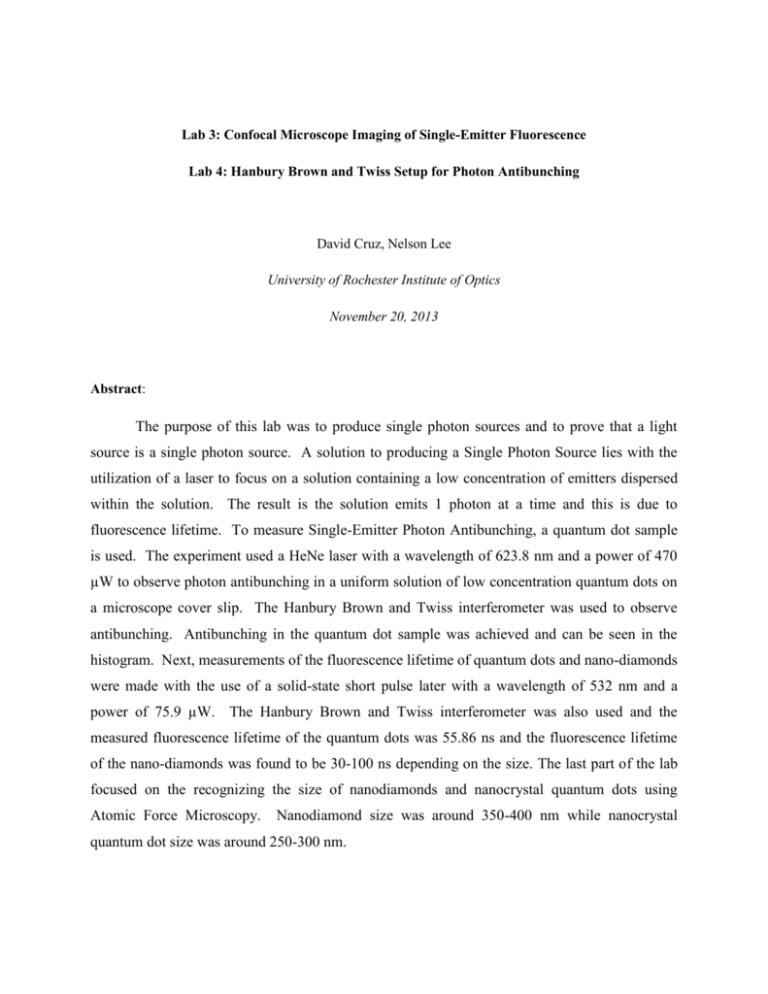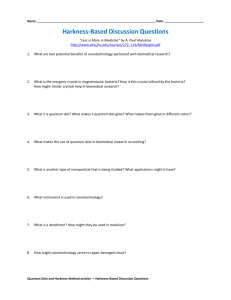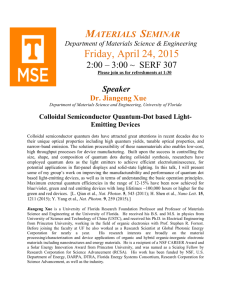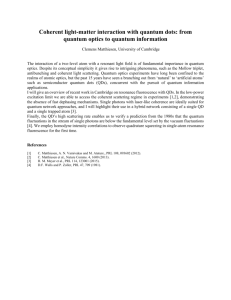Lab 3-4_Single Photon Sources_OPT 253_Cruz
advertisement

Lab 3: Confocal Microscope Imaging of Single-Emitter Fluorescence Lab 4: Hanbury Brown and Twiss Setup for Photon Antibunching David Cruz, Nelson Lee University of Rochester Institute of Optics November 20, 2013 Abstract: The purpose of this lab was to produce single photon sources and to prove that a light source is a single photon source. A solution to producing a Single Photon Source lies with the utilization of a laser to focus on a solution containing a low concentration of emitters dispersed within the solution. The result is the solution emits 1 photon at a time and this is due to fluorescence lifetime. To measure Single-Emitter Photon Antibunching, a quantum dot sample is used. The experiment used a HeNe laser with a wavelength of 623.8 nm and a power of 470 µW to observe photon antibunching in a uniform solution of low concentration quantum dots on a microscope cover slip. The Hanbury Brown and Twiss interferometer was used to observe antibunching. Antibunching in the quantum dot sample was achieved and can be seen in the histogram. Next, measurements of the fluorescence lifetime of quantum dots and nano-diamonds were made with the use of a solid-state short pulse later with a wavelength of 532 nm and a power of 75.9 µW. The Hanbury Brown and Twiss interferometer was also used and the measured fluorescence lifetime of the quantum dots was 55.86 ns and the fluorescence lifetime of the nano-diamonds was found to be 30-100 ns depending on the size. The last part of the lab focused on the recognizing the size of nanodiamonds and nanocrystal quantum dots using Atomic Force Microscopy. Nanodiamond size was around 350-400 nm while nanocrystal quantum dot size was around 250-300 nm. Introduction: Single photon sources produce photons that exhibit antibunching. Mandel and Kimble first observed photon antibunching in 1967 in which micro cavities were used in order to enhance single emitter fluorescence. 1-D photonic band-gap materials can be used and eventually 2D photonic crystals became available. These materials exhibit non-linear periodic structures that makes it useful in optics because of selective reflection. This property of single photon sources is important in many applications such as in quantum information technology, quantum computation, quantum communication and quantum cryptography. Single photon sources holds the ability to prevent potential eavesdroppers from intercepting a message making communication securer. This is because of the Heisenberg uncertainty relation which tells us that any quantum measurements will influence the observed state of the system. When an eavesdropper intercepts the message, the sender or recipient can detect the change in state. This form of quantum communication has potential however, the problem is that a reliable single photon source has to be developed. Several solutions to this problem exist in literature but the practical applications are limited because the Baud-rate is limited and also pollution restrictions exist especially on faintpulse quantum cryptography and creating an efficient and reliable light source that delivers pulses that contain a single photon is difficult. These problems hinder practical applications for the use of single photon sources in quantum computing and quantum communication. Background: A possible solution lies with the utilization of a laser to tightly focus on a solution containing a low concentration of emitters uniformly dispersed within the solution. A laser source provides an external field that is used to excite a single emitter and emits 1 photon at a time. The release of a single photon at a time is synonymous with photonic antibunching properties. To realize antibunching, a second order correlation function g(2) can be used in conjunction with the Hanbury Brown and Twiss Interferometer. g(2) is proportional to the measured coincidence count rate which is the number of second photons that appeared after the first measured photon. g(2) (0) should be less than 1, where g(2)(τ) is defined as: 𝑔(2) (𝜏) = ⟨𝑛1 (𝑡)𝑛2 (𝑡 + 𝜏)⟩ ⟨𝑛1 (𝑡)⟩⟨𝑛2 (𝑡 + 𝜏)⟩ Antibunching is due to fluorescence lifetime (See figure 1). Fluorescence lifetime is the average time that the molecule is excited before it releases a single photon. This phenomenon can be described using the following equation: N (t ) N o e ( t / ) Where N(t) is the concentration of excited state molecules at time t, No is the initial concentration of excited state molecules and τ is the fluorescence lifetime. Excited State Detector Light Source Ground State Figure 1 (Left) outlines the process in which the single emitter is excited using a light source and single photon is emitted detected by a very sensitive detector. Atomic microscope microscopy is a type of scanning system that consists of a cantilever with a probe at the end with a very small and sharp tip. Its imaging modes are contact mode, noncontact mode and tapping mode. This experiment used contact mode. The tip comes in contact with the specimen and the probe experiences a small displacement. This deflection goes in accordance to Hooke's law. By scanning the specimen (moving the probe along the specimen) we and recording the displacements, it is possible to image the surface of the specimen. Experimental Setup: I. Confocal Fluorescence Microscopy For this lab a confocal fluorescence microscope was used for imaging quantum dots and nanodiamonds to observe single photon emittance, confirm anti-bunching, and measure fluorescence lifetime. The microscope will be used to focus the laser onto a sample of a single emitter host and collect and image the resulting fluorescence. There are six main elements of the confocal microscope. These are: laser, objective, sample table, scanning system, pinhole, and detector. The detectors for this lab consist of either the Hanbury Brown and Twiss setup, which is described in detail later, or an EM-CCD camera, which has been used in previous lab exercises. The EM-CCD camera is used for alignment and focusing. The detector that is being used depends on the port selected on the microscope output Figure 2: Schematic of Confocal Fluorescence Microscope The dichoric mirror and barrier filters are used to separate fluorescence of single-photon emitters from the excitation light of the laser source. There were two lasers used for this experiment. The first was a HeNe laser with wavelength of 632.8 nm and approximately 470 μW. The second laser used in this lab is a diode-pumped solid-state laser with a wavelength of 532 nm; 6 pico-second pulse duration at 76 MHz; and approximately 75.9 μW. Some advantages of confocal microscopy are the ability to control depth of field, and eliminating out of focus light. The oil immersion objective of the confocal microscope allows for greater resolution and brightness. For the avalanche photodiodes (APDs), EM-CCD camera, and the lasers, it is important to follow certain steps to avoid damaging them. All operations when the APDs and EM-CCD cameras are powered on are to be done with the lights off. If the APDs are under a very high count rate (200,000 counts/second) shield the APDs from the laser light before switching them off. After powering off the switch to the APDs always unplug the modules. The EM-CCD camera is internally cooled and works at an internal temperature of -60° C. Never disrupt the cooling mechanism, and if the camera temperature is too high to operate, a buzzer alarm will go off. When powering on and off the laser, it is important to exercise caution, as it can be harmful to the eyes. It is necessary to press the stop button before turning the key to power off the laser II. Hanbury Brown and Twiss Setup The Hanbury Brown and Twiss setup consists of a beamsplitter, two single-photon counting avalanche photodiodes (APDs), and a computer card, TimeHarp 200. Figure 3: Hanbury Brown and Twiss Setup The APD’s detector area is approximately 170 μm, and each detector serves as a pinhole. The beam splitter directs half of the incident photons towards each APD. One detector provides the “start” signal and the other provides the “stop” signal. The time between these signals forms a histogram of time delay between two consecutive photons and coincidence count which will show whether or not photon antibunching occurred. We will also use this setup to measure fluorescence lifetime duration. This is done by having one detector provide the “start” signal, and the “stop” signal being provided by the pulsed laser. III. Atomic Force Microscopy An introduction to the use of an Atomic Force Microscope (AFM) was done in this lab to image quantum dots and nano-diamonds as well as some other calibration surfaces. Figure 4: Atomic Force Microscope Schematic The AFM works by sensing intermolecular forces between the tip of the probe and the sample surface and provides an accurate characterization of the surface. Images of quantum dots and nano-diamonds are shown in the results section to give us a good representation of the scale of these single-emitters. Procedure: I. Measuring Single-Emitter Photon Antibunching of Quantum Dot Sample To measure antibunching we will use a HeNe laser of wavelength of 623.8 nm and approximately 470 μW, and a confocal microscope with an EM-CCD camera and a Hanbury Brown and Twiss setup. 1. A sample is prepared by placing a drop of a diluted solution of quantum dots on a microscope cover slip. It is then placed on a spin coater to evenly distribute the solution. 2. Prepare microscope objective by cleaning with acetone. Place drop of immersion fluid on lens and place the sample over the objective and secure it in place on the stage with magnets. 3. Place second order ND filters at the input of the confocal microscope to attenuate the laser source and remove filters if necessary. 4. Set the output of the microscope to the port with the EM-CCD camera. Align the beam and observe the “blinking” phenomenon of these quantum dots. 5. Now set the output of the microscope to the port with the Hanbury Brown and Twiss set in order to measure weather we have attained photon antibunching. 6. Start the LabView program and begin acquiring images with the APDs. Focus the stage on a desired area of the sample and initiate the TimeHarp software to record a histogram in order to confirm we have a sample that exhibits single-emitter photon antibunching. II. Measuring Fluorescence Lifetime of Quantum Dots and Nano-Diamonds To measure fluorescence lifetime we will use a solid-state short pulse laser of 532 nm wavelength, 75.9 μW and set up the microscope with the Hanbury Brown and Twiss setup similar to what was used in step I. 1. Setup the Hanbury Brown and Twiss setup to measure fluorescence lifetime by having one APD provide the “start” signal and the pulsed laser providing the “stop” signal. 2. Calibrate the zero point of these signals, which was determined to be 55.86 ns 3. Place a sample of quantum dots on the objective. Start the LabView program and begin acquiring images with the APDs. 4. Focus the stage on a desired area of the sample and initiate the TimeHarp software to record fluorescence lifetime. Adjust the delay if necessary. 5. Repeat steps 1-4 for a sample of nano-diamonds. a. This sample is prepared by placing a mixture of liquid crystals and nano-diamonds on a microscope cover slip. Mix them together until evenly distributed. Place another cover slip on top and rub these two substrates together unilaterally to align the crystals. This creates a cholesteric 1-D photonic bandgap structure III. Atomic Force Microscopy – Quantum Dot and Nano-Diamond Imaging 1. Place a sample of quantum dots on the stage of the AFM. 2. Begin a 25x25 μm scan of the sample. 3. Zoom in on an area of interest and continue scanning until a single quantum dot is characterized. 4. Repeat 1-3 for a sample of nano-diamonds. Results and Analysis: I. Photon Antibunching of Quantum Dot Sample The following data for quantum dot fluorescence to confirm antibunching was taken with the LabView software and the Hanbury Brown and Twiss setup. We can see bright clusters as well as what looks like single emitters. For the purpose of this lab we ideally would like to characterize the single emitters. These quantum dots fluoresce at 800nm wavelength excited by a HeNe laser of 632.8 nm wavelength, 470 μW attenuated by 2nd order filtration. Figure 5: (Top) Quantum dot raster scans of APDs 1 (left) and 2 (right); (Bottom) Time trace of quantum dot fluorescence where each pulse represents the blinking of quantum dots We can see from the time trace that we do have blinking quantum dots. The TimeHarp 200 computer card recorded the photon counts that were detected by the APDs to confirm we do indeed have anthibunching by our quantum dot sample as shown in Figure 6 Figure 6: Antibunching histogram of quantum dot sample (zero point at 55.86 ns) Figure 7: Quantum dots fluorescing imaged with EM-CCD camera The above image is from a video that was recorded using the EM-CCD camera. We can see the blinking nature of the quantum dots, with the brighter spots representing clusters. II. Measuring Fluorescence Lifetime The following graph was obtained in the TimeHarp software to calibrate the zero point, which came to be 55.86 ns: Figure 8: Zero point calibration of the “start-stop” signal for the APD and pulsed laser The following images show the measurements for fluorescence lifetime of quantum dots. Multiple measurements were taken in order to acquire a good sample size. Figure 9: (Top) Quantum dot raster scans of APDs 1 and 2; (Bottom) Time trace of quantum dot fluorescence Figure 10 shows the decay of the fluorescence lifetime. Figure 10: Fluorescence lifetime of Quantum dot sample Fluorescence of 1-D photonic bandgap structure, nano-diamonds in a liquid crystal host. Figure 11: Nano-diamond in liquid crystal host raster scan Figure 12: Fluorescence lifetime of nano-diamonds in liquid crystal host. III. Atomic Force Microscopy – Quantum Dot and Nano-Diamond Imaging This section of the lab is straightforward and involves using the AFM to image samples of quantum dots and nano-diamonds. It will give us a good idea to the scale of these single-emitters. Figure 13: (Left) Nano-diamond sample 25x25 μm scan; (Center) 6.25 x 6.25 μm scan; (Right) 3-D map Figure 14: Nano-Diamond sample: (left) 1.39 x 1.39 μm scan ; (right) 451 x 451 nm scan Figure 15: Quantum Dot Sample: (left) 25 x 25 μm scan; (center) 5.47 x 5.47 μm scan; (right) 1.05 x 1.05 μm scan Figures 13 through 15 shows the size of a single nano-diamond is approximately 350-400 nm, although we chose to image a fairly large one. The single quantum dot measures approximately 250-300 nm. Conclusion: Many applications for future and developing technologies rely on the quantum properties associated with single photon sources. But, problems exist for applications include quantum computing and quantum communication due to the need for reliable single photon sources. This experiment shed light on a reliable method to produce single photon sources by using fluorescence imaging of quantum dots using the Hanbury Brown and Twiss interferometer. The measured antibunching histograms and time trace showed antibunching and quantum blinking. To observe antibunching, g(2) (0) should be less than 1 and the calculated fluorescent lifetime for the quantum dots and experimental setup (See procedure) was measured to be between 30-100 ns. Also with the use of Atomic Force microscopy, the size of the nanodiamonds and quantum dots were measured to be approximately, 350-400 nm and 250-300 nm, respectively. References: 1. Lukishova, Svetlana. Lab 3 & 4 Manual, Web. Fall 2013. http://www.optics.rochester.edu/workgroups/lukishova/QuantumOpticsLab/homepage/op t253_labs_3_4_manual_08.pdf 2. http://www.microscopyu.com 3. Zwiller, V; Aichele, T.; and Oliver, B. (2004 July 29). Quantum optics with single quantum dot devices. New J. Phys. 6 (2004) 96 http://iopscience.iop.org/13672630/6/1/096/fulltext/ 4. http://www.nano-ou.net/eduIntro2.aspx Contributions: Under the guidance of Dr. Svetlana Lukishova, all members contributed equally during lab to prepare samples, and collect and analyze data. Nelson Lee wrote the “Abstract” and “Introduction and Background”, and “Conclusion” sections. David Cruz wrote the “Experimental Setup”, “Procedure”, and “Results and Analysis” sections.







